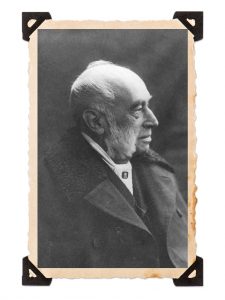The Beginning...
1859
 William Rathbone, a Liverpool merchant and philanthropist, had employed a nurse, Mary Robinson, to nurse his wife at home during her final illness. After his wife’s death, he retained Mary Robinson’s services so that people in Liverpool who could not afford to pay for nursing would benefit from care in their own homes. Seeing the good that nursing in the home could do, William Rathbone and Florence Nightingale worked together to try to develop the service. When too few trained nurses could be found, Rathbone set up and funded a nursing school in Liverpool specifically to train nurses for the 18 ‘districts’ of the City – and so organised ‘district nursing’ began.
William Rathbone, a Liverpool merchant and philanthropist, had employed a nurse, Mary Robinson, to nurse his wife at home during her final illness. After his wife’s death, he retained Mary Robinson’s services so that people in Liverpool who could not afford to pay for nursing would benefit from care in their own homes. Seeing the good that nursing in the home could do, William Rathbone and Florence Nightingale worked together to try to develop the service. When too few trained nurses could be found, Rathbone set up and funded a nursing school in Liverpool specifically to train nurses for the 18 ‘districts’ of the City – and so organised ‘district nursing’ began.
Read more about William Rathbone and the beginning of District Nursing >
1887
 The Queen’s Nursing Institute began in 1887, with the grant of £70,000 by Queen Victoria from the Women’s Jubilee Fund. A Royal Charter in 1889 named it ‘Queen Victoria’s Jubilee Institute for Nurses’, and gave it the objectives of providing the ‘training, support, maintenance and supply’ of nurses for the sick poor, as well as establishing training homes, supervising centres, co-operating with other bodies and establishes Branches as necessary.
The Queen’s Nursing Institute began in 1887, with the grant of £70,000 by Queen Victoria from the Women’s Jubilee Fund. A Royal Charter in 1889 named it ‘Queen Victoria’s Jubilee Institute for Nurses’, and gave it the objectives of providing the ‘training, support, maintenance and supply’ of nurses for the sick poor, as well as establishing training homes, supervising centres, co-operating with other bodies and establishes Branches as necessary.
1904
The QNI’s welfare function was founded in 1904. Originally created to provide support to Queen’s Nurses, financial assistance is now available to all community nurses who are either retired or whose careers are threatened by ill-health or personal crisis.
You can read more about help that the QNI offers here.
1909
In 1909, the Jubilee Congress of District Nursing celebrated 50 years of the profession, with branches of the Institute in Scotland and Ireland, and visitors to the Congress from district nursing associations from as far afield as the United States, Bermuda, Norway and Australia.
1927

The National Garden Scheme was founded in 1927 to raise money for the nurses of the Queen’s Nursing Institute by opening gardens of quality and interest to the public.
Visit the National Garden Scheme website.
1928
The name of the Institute is changed to the ‘Queen’s Institute of District Nursing’.
1948
The National Health Service comes into operation and District Nursing services become free for all patients for the first time.
1968
The Institute stops training nurses, offering different forms of professional support instead.
1973
The Institute becomes known as ‘The Queen’s Nursing Institute’.
Visit the Queen’s Nursing Institute website.
1987
The QNI celebrates its Centenary: 1887-1987.
1990
The QNI began to offer professional development and financial grants to community nurses to lead projects in their local area. Today known as the Fund for Innovation and Leadership, the scheme has funded hundreds of projects in England, Wales and Northern Ireland and benefited thousands of patients, carers and families.
Read more here.
1994
The Queen Elizabeth the Queen Mother Award for Outstanding Service is created in 1994. It is presented to nurses who have given exceptional service to patients through nursing practice in any aspect of primary health care.
2007
The QNI reinstates the title of Queen’s Nurse after an absence of 40 years.
Community nurses who have at least five years’ experience can apply for the title. Today there are over 2500 Queen’s Nurses, who are committed to high standards of practice and patient care, learning and leadership.
In 2017 the Queen’s Nurse title was also reintroduced in Scotland.
Read more here.
2009
The QNI publishes ‘2020 Vision’, a major new report focusing on the future of district nursing.
2017
The QNI celebrates its 130th Anniversary.
The Future...